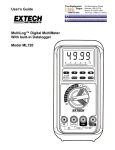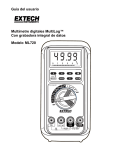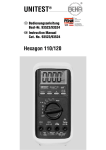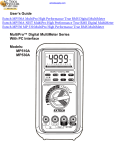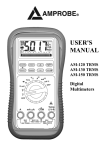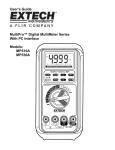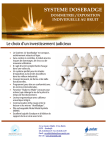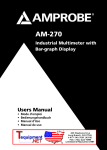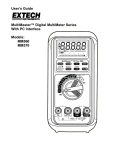Download Altech MultiPro 2000 User`s guide
Transcript
User’s Guide MultiPro™ Digital MultiMeter Series With PC Interface Models: MP510 MP520 MP530 1 WARRANTY EXTECH INSTRUMENTS CORPORATION warrants this instrument to be free of defects in parts and workmanship for three years from date of shipment (a six month limited warranty applies on sensors and cables). If it should become necessary to return the instrument for service during or beyond the warranty period, contact the Customer Service Department at (781) 890-7440 ext. 210 for authorization. A Return Authorization (RA) number must be issued before any product is returned to Extech. The sender is responsible for shipping charges, freight, insurance and proper packaging to prevent damage in transit. This warranty does not apply to defects resulting from action of the user such as misuse, improper wiring, operation outside of specification, improper maintenance or repair, or unauthorized modification. Extech specifically disclaims any implied warranties or merchantability or fitness for a specific purpose and will not be liable for any direct, indirect, incidental or consequential damages. Extech's total liability is limited to repair or replacement of the product. The warranty set forth above is inclusive and no other warranty, whether written or oral, is expressed or implied. REPAIR AND CALIBRATION SERVICES Extech offers complete repair and calibration services for all of the products we sell. For periodic calibration, NIST certification or repair of any Extech product, call customer service for details on services available. Extech recommends that calibration be performed on an annual basis to insure calibration integrity. Support Hotline (781) 890-7440 Tech support: Ext. 200; Email: [email protected] Repair/Returns: Ext. 210; Email: [email protected] Website: www.extech.com Copyright © 2002 Extech Instruments Corporation. All rights reserved including the right of reproduction in whole or in part in any form. MP Series V2.2 9/03 P/N: 7M1C-0241-A000 Introduction 2 Congratulations on your purchase of Extech model MP510, MP520, or MP530 digital multimeter. Properly used, this meter will provide many years of reliable service. MultiPro™ Meters measure AC/DC Voltage, AC/DC Current, Resistance, Frequency, Capacitance, Diode, and Continuity. The MultiPro™ also offers RS-232 PC Interface data acquisition capabilities as an option. Models MP520 and MP530 are True RMS AC sensing. In addition, the MP530 offers Temperature, Relative, Peak capture and MIN/MAX functions. Safety International Safety Symbols This symbol, adjacent to another symbol or terminal, indicates the user must refer to the manual for further information. This symbol, adjacent to a terminal, indicates that, under normal use, hazardous voltages may be present Double insulation Safety Precautions 1. Improper use of this meter can cause damage, shock, injury or death. Read and understand this users manual before operating the meter. 2. Make sure any covers or battery doors are properly closed and secured. 3. Always remove the test leads before replacing the battery or fuses. 4. Inspect the condition of the test leads and the meter itself for any damage before operating the meter. Repair or replace any damage before use. 5. Do not exceed the maximum rated input limits. 6. Use great care when making measurements if the voltages are greater than 25VAC rms or 35VDC. These voltages are considered a shock hazard. 7. Always discharge capacitors and remove power from the device under test before performing Capacitance, Diode, Resistance or Continuity tests. 3 8. Remove the battery from the meter if the meter is to be stored for long periods. 9. To avoid electric shock, do not measure AC current on any circuit whose voltage exceeds 500V AC. 10. Voltage checks on electrical outlets can be difficult and misleading because of the uncertainty of connection to the electrical contacts. Other means should be used to ensure that the terminals are not "live". 11. The product is intended only for indoor use 12. If the equipment is used in a manner not specified by the manufacturer, the protection provided by the equipment may be impaired. 13. Pollution degree: 2 PER IEC1010 OVERVOLTAGE INSTALLATION CATEGORY OVERVOLTAGE CATEGORY I Equipment of OVERVOLTAGE CATEGORY I is equipment for connection to circuits in which measures are taken to limit the transient overvoltages to an appropriate low level. Note – Examples include protected electronic circuits. OVERVOLTAGE CATEGORY II Equipment of OVERVOLTAGE CATEGORY II is energy-consuming equipment to be supplied from the fixed installation. Note – Examples include household, office, and laboratory appliances. OVERVOLTAGE CATEGORY III Equipment of OVERVOLTAGE CATEGORY III is equipment in fixed installations. Note – Examples include switches in the fixed installation and some equipment for industrial use with permanent connection to the fixed installation. OVERVOLTAGE CATEGORY IV Equipment of OVERVOLTAGE CATEGORY IV is for use at the origin of the installation. Note – Examples include electricity meters and primary over-current protection equipment Specifications 4 DC VOLTAGE RANGE Accuracy 50.00 mV 0.12% + 2d 500.0 mV 0.06% + 2d 5.000V, 50.00V, 500.0V, 1000V 0.08% + 2d NMRR: >60dB @ 50/60Hz, CMRR: >120dB @ DC, 50/60Hz, Rs=1kΩ Input impedance: 10MΩ, 16pF nominal (44pF nominal for 50mV & 500mV ranges) AC VOLTAGE RANGE Accuracy 50Hz/60Hz 50.00mV, 500.0mV, 5.000V, 50.00V, 500.0V, 1000V 0.5% + 3d 40Hz to 500Hz 50.00mV, 500.0mV 0.8% + 3d 5.000V, 50.00V, 500.0V 1.0% + 4d 1000V 1.2% + 4d Up to 20kHz 50.00mV, 500.0mV 0.5dB* 5.000V, 50.00V, 500.0V 3dB* 1000V Unspecified *Specified from 30% to 100% of range CMRR: >60dB @ DC to 60Hz, Rs=1kΩ Input Impedance: 10MΩ, 16pF nominal (44pF nominal for 50mV & 500mV ranges) DC CURRENT RANGE Accuracy Burden Voltage 500.0µA, 5000µA 0.15mV/µA 0.2% + 4d 50.00mA, 500.0mA 3.3mV/mA 5.000A, 10.00A* 0.03V/A *10A continuous, 20A for 30 seconds max with a 5 minute cool down interval AC CURRENT RANGE Accuracy Burden Voltage 50 / 60Hz 0.6%+3d 500.0µA, 5000µA 0.15mV/µA 50.00mA, 500.0mA 0.6%+3d 3.3mV/mA 5.000A, 10.00A* 0.6%+3d 0.03V/A 40Hz to 1kHz 0.8%+4d 500.0µA, 5000µA 0.15mV/µA 50.00mA 0.8%+4d 3.3mV/mA 500.0mA 1.0%+4d 3.3mV/mA 5.000A, 10.00A* 0.8%+4d 0.03V/A *10A continuous, 20A for 30-second max with 5 minutes cool down interval Peak Capture (for V & A) Specified accuracy ±150 digits for changes > 5 ms in duration TEMPERATURE (MP530 ONLY) RANGE Accuracy 0.3% + 3d -50°C TO 1000°C 0.3% + 6d -58°F TO 1832°F RESISTANCE RANGE Accuracy 0.2% + 6d 50.00Ω 0.1% + 3d 500.0Ω 0.1% + 2d 5.000kΩ, 50.00kΩ, 500.0kΩ 0.4% + 3d 5.000MΩ 1.5% + 5d 50.00MΩ Open Circuit Voltage: < 1.3VDC (< 3VDC for 50Ω & 500Ω ranges) CAPACITANCE RANGE Accuracy* 50.00nF, 500.0nF 0.8% + 3d 1.0% + 3d 5.000µF 2.0% + 3d 50.00µF 3.5% + 5d 500.0µF 5.0% + 5d 9999µF *Accuracies with film capacitor or better 5 FREQUENCY Function 6 Sensitivity (ACrms) 300mV 2V 20V 80V 300V 300mV 10% F.S. Range mV 10Hz - 125kHz 5V 10Hz - 125kHz 50V 10Hz - 20kHz 500V 10Hz - 1kHz 1000V 10Hz - 1kHz 10Hz - 125kHz Ω, Cx, diode 10Hz - 125kHz µA, mA, A Accuracy: 0.01% + 2d Audible Continuity: Measurement threshold: Beeper will sound if measurement is below 20Ω. Beeper will not sound if measurement is above 200Ω. Beeper may or may not sound if measurement is between 20 and 200Ω. Response time: < 100µs Accuracy Notes: Accuracy is ± (% reading digits + number of digits), or as otherwise specified, at 23°C ±5°C < 75% R.H. True RMS accuracies are specified from 5% to 100% of range or as otherwise specified. Maximum Crest Factor <3:1 at full scale & <6:1 at half scale (with frequency component within the specified frequency bandwidth for nonsinusoidal waveforms). Digital Display: 5000-count LCD display; 5 per second nominal refresh rate Bar Graph Display: 52-segment bargraph; 60 per second nominal refresh rate Low Battery: Below approx. 7V Operating Temperature: 41° to 104°F (5° to 40°C) Storage Temperature: -4° to 140°F (-20 to 60oC Relative Humidity: Max 80% up to 87ºF (31ºC) decreasing linearly to 50% at 104ºF(40ºC): <80% storage Altitude: Operating below 2000 meters Temp. Coefficient: Nominal 0.15 x specified accuracy per ºC (between 0 and 18oC or 28 to 50oC), or as otherwise specified Power Supply: 9V battery (NEDA1604, JIS006P or IEC6F22) 7 AC Sensing: True RMS on MP520 and MP530 Auto Power Off: After 17 minutes of inactivity with no input signal Safety: The MultiPro™ Series meters are intended for indoor use and protected, against the users, by double insulation per EN61010-1 and IEC61010-1 2nd Edition (2001) to CAT III 1000V & CAT IV 600V. The meter (all versions) also meets UL3111-1(1994)* and CSA C22.2 No. 1010-1-92* to CAT III 1000V. Terminals (to COM) ratings: V: CATEGORY III 1000 VOLTS AC & DC, AND CATEGORY IV* 600 VOLTS AC & DC. A / MAµA : CATEGORY III AND CATEGORY IV* 500 VOLTS AC AND 300 VOLTS DC. *Category IV safety standard (for DMMs) was first released in IEC61010-1 2nd Edition in year 2001, and was yet an UL published standard at the time this manual was written. UL Certification: The meter that bears the UL markings, if any, has been investigated by UL headquarter in the USA per UL standard UL3111-1 1st Ed to its highest CAT III rating and international standard IEC61010-1 Second Edition (year 2001) to CAT IV rating. The UL markings on the meter, where applicable, are marked as “UL Listed Cat III only” and “UL Classified to IEC61010-1 2nd Ed. Cat IV”. E.M.C.: Meets EN61326(1997, 1998/A1), EN61000-4-2(1995) and EN61000-4-3(1996). Also meets former standards EN55011 (1991) and EN50082-1(1997) In an RF field of 3V/m: Capacitance function is not specified Other function ranges: Total Accuracy = Specified Accuracy + 30 digits. Performance above 3V/m is not specified Overload Protection: µA/mA Range: 0.63/500V, IR 200kA, F fuse. 12.5A/500V IR 20kA, F fuse. A Range: 1050V rms, 1450V peak V Range: mV, Ω and other: 600VDC/VAC rms Power Consumption: 2.7 mA typical Dimension: 7.32 x 3.43 x 1.4" with holster (186mm x 87mm x 35.5mm) Weight: 15.17 oz. with holster (430g) Meter Description (MP530 Shown) 8 1. 5000 count Liquid Crystal display 2. Function push-buttons 3. Rotary function switch 4. 10A input jack 5. V/Hz/Ω/Cap/Temp input jack 6. COM input jack 7. mA/uA current input jack NOTE: RS-232 Optical interface is located on the top rear of the meter. Features Analog Bargraph display Visual indication of measurement in the tradition of an analog meter pointer. The bargraph consists of 52 discrete viewing segments. The bargraph is useful for detecting faulty contacts, identifying potentiometer gradations, and viewing signal spikes. True RMS vs. Average Sensing (AC Measurements) True RMS meters can accurately measure non-sinusoidal waveforms, as well as distorted sine waves that contain harmonics. Average Sensing is a fast, accurate and cost effective method of measuring pure sine wave signals. However, non-sinusoidal waveforms cannot accurately be measured using Average-sensing techniques. NOTE: The MP510 is average sensing; the MP520 and MP530 are True RMS. Backlit display The MultiPro™ series multimeters are equipped with a backlight for viewing the LCD display in poorly lit areas. 9 Data Hold The HOLD function freezes the reading on the display for later viewing. Manual and Automatic Ranging The MultiPro™ series multimeters are Autoranging, with manual override. Smart Power Auto Power Off Smart Power shuts the meter down automatically after approximately 17 minutes of inactivity. Audible Beeper To disable the audible meter tones, press and hold the Hz key while powering the meter. Automatic Test Lead Resistance Compensation Automatically compensates for the resistance of the test leads, as well as the internal protection circuitry automatically, ensuring greater accuracy of low resistance measurements. MAX/MIN mode (MP530 only) MAX/MIN mode stores the minimum and maximum readings in memory for later viewing. Relative mode (MP530 only) Relative mode allows the meter to display the difference between the actual measurement and a stored reference value. Zoom mode analog pointer (MP530 only) The Zoom mode magnifies the regular analog bar graph resolution (up to 5 times) to show small signal changes PeakC capture mode (MP530 only) PeakC captures voltage or current signal that have durations as short as 5ms. This mode is available in DCV, ACV, DCA, & ACA functions. Operation 10 Measurement Considerations NOTICE: Read and understand all warning and caution statements listed in the safety section of this operation manual prior to using this meter. 1. Always move the rotary function switch to the OFF position when the meter is not in use. This meter has Auto Power OFF that automatically shuts the meter OFF if 17 minutes elapse without activity. 2. If "OL" appears on the display during a measurement, the measurement exceeds the range selected. Change to a higher range. AC/DC Voltage Measurements 1. Insert the black test lead into the negative COM jack and the red test lead into the positive V jack. 2. Set the function switch to the "VAC" "VDC" "mV" position. Press the SELECT key momentarily to toggle between AC and DC. 3. Read the voltage measurement on the display AC/DC Current Measurements CAUTION: Do not make current measurements at 20A for longer than 30 seconds. Exceeding 30 seconds may cause damage to the meter and/or the test leads. 1. Insert the black test lead into the negative COM jack. 2. For current measurements up to 4000µA, set the function switch to the "µA" position and insert the red test lead into the mA-µA jack. 3. For current measurements up to 400mA, set the function switch to the "mA" position and insert the red test lead into the mA-µA jack. 4. For current measurements up to 10A, set the function switch to the "A" position and insert the red test lead into the A jack. 5. Press the SELECT key momentarily to toggle between AC and DC. 6. Remove power from the circuit under test and open the circuit at the point where you wish to measure current. 7. Touch the black test probe tip to the negative side of the circuit and touch the red test probe tip to the positive side of the circuit. 8. Apply power to the circuit. 9. Read the current on the display 11 Resistance and Continuity Measurements 1. Insert the black test lead banana plug into the negative COM jack and the red test lead banana plug into the V/Ω/CAP jack. 2. Set the function switch to the "Ω " position. 3. Press the SELECT key momentarily to select Continuity (if required). 4. Touch the test probe tips across the circuit or part under test. It is best to disconnect one side of the part under test so the rest of the circuit will not interfere with the resistance reading. 5. For Resistance tests, read the resistance on the display. 6. For Continuity tests, If the resistance is < 20Ω, an audible tone will sound Automatic test lead resistance calibration When manually entering the 50Ω range (using the RANGE key) the automatic test lead resistance feature will prompt ("Shrt" in the display) the user to short the inputs for calibration. Short the test leads for about 3 seconds until the display shows zero. The resistance of the test leads is now subtracted from the reading. The compensation value can be as much as 5Ω. Note: The compensation procedure must be repeated each time the range or function is changed. Capacitance Measurements 1. Insert the black lead into the negative COM jack and the red test lead into the positive CAP jack. 2. Set the function switch to the " CAP" position. 3. Press the SELECT key momentarily to select Capacitance (if required). 4. Touch the test leads to the capacitor to be tested and read the measured value. 12 Frequency Measurements 1. Connect and make the measurement required as described in the previous paragraphs. 2. Press the Hz key to select the Frequency (Hz) function. 3. Read the frequency on the display Notes on sensitivity: Input sensitivity varies automatically with function range selected. The mV function has the highest (300mV) and the 1000V range has the lowest (300V) sensitivity. It is recommended that the user first measure the signal voltage (or current) level before activating the Hz function to automatically set the most appropriate trigger level. You can also press the RANGE button momentarily to select another trigger level manually. If the Hz reading becomes unstable, select a lower sensitivity to avoid electrical noise. If the display is zero, select a higher sensitivity. Diode Test 1. Insert the black lead into the negative COM jack and the red test lead into the positive jack 2. Set the function switch to " CAP" position. 3. Press the SELECT key momentarily to select the diode function (if required). 4. Touch the test probe tips to the diode or semiconductor junction you wish to test. Note the meter reading. 5. Reverse the test lead polarity by reversing the red and black leads. Note this reading. 6. The diode or junction can be evaluated as follows: A. If one reading displays a value and the other reading displays "OL", the diode is good. B. If both readings display "OL", the device is open. C. If both readings are very small or 0, the device is shorted. Temperature Measurements (MP530 only) 1. Insert the Temperature Probe into the COM and TEMP input jacks observing polarity. 2. Set the function switch to the "TEMP" position. 3. Use the SELECT key to toggle between oC and oF. 4. Touch the Temperature Probe tip to the device under test. 5. Wait 30 seconds for the measurement to stabilize then read the display. 13 MAX/MIN (MP530 only) 1. Press the MAX/MIN key to activate the MAX/MIN recording mode. The display annunciators "MAX/MIN" will appear. The meter will beep every time a new maximum or minimum reading is sensed. Auto power off is disabled while in MAX/MIN mode. 2. Press the MAX/MIN key to cycle through the stored MAX (maximum), MIN (minimum) and MAX-MIN (maximum minus minimum) readings. 3. To exit MAX/MIN mode press and hold the MAX/MIN key for 2 seconds. Relative mode (MP530 only) 1. Press the key once to a store the displayed reading as the reference value. The display will now show readings relative to the stored reference value. (display = reading - stored value) 2. Press the Relative key again to exit the Relative mode. Peak C capture mode (MP530 only) 1. Press the Peak C key momentarily to activate Peak Mode, which captures voltage or current signal durations as short as 5ms. This mode is available in DCV, ACV, DCA, & ACA functions (the display annunciators "C" & "MAX" appear). The Auto Power Off feature will be disabled automatically in this mode. 2. The meter will beep whenever a new maximum or minimum reading is detected. 3. Press the Peak key to cycle through the Maximum (MAX), Minimum (MIN), and Maximum minus Minimum (MAX-MIN) readings. 4. Press the PEAK key for 1 second to exit PEAK capture mode. Smart Power™ Auto Power Off Smart Power™ shuts the meter down automatically after approximately 17 minutes of inactivity. The 17-minute time period is reset any time the rotary switch is moved or as long as a signal is being fed into the meter is greater than 10% of the range. This prevents auto powering off during long term tests. To wake the meter, press the SELECT key or turn the meter off and on again. Disabling Auto Power Off Press the RANGE key while turning the meter on to disable the Auto Power Off feature Audible Beeper The audible beeper can be disabled by pressing the Hz key while turning the meter on. RS-232 PC Interface 14 This instrument is equipped with an optically isolated interface port (located on the rear of the meter). An optional WindowsTM software (part no. SW800) and interface package is available for data acquisition applications. This optional kit is required to connect the meter to a PC. The software provides digital, analog, and graphical data displays. Refer to the README file in the interface kit for further details. Maintenance WARNING To avoid electrical shock, disconnect the meter from any circuit, remove the test leads from the input jacks and turn OFF the meter before opening the case. Do not operate with open case. Install only the same type of fuse or equivalent Cleaning and Storage Periodically wipe the case with a damp cloth and mild detergent; do not use abrasives or solvents. If the meter is not to be used for periods of longer than 60 days, remove the battery and store it separately 15 Battery Replacement Loosen the 2 screws from the battery access door of the case bottom. Lift the battery access door and thus the battery compartment up. Replace the battery. Re-fasten the screws. Battery: Standard 9V Alkaline (NEDA1604, JIS006P, IEC6F22) Fuse Replacement 1. Remove the four screws from the case bottom and stand using a Philips head screwdriver. 2. Lift the end of the case bottom nearest the input jacks until it unsnaps from the case top 3. Replace the battery or blown fuse(s) 4. Replace the case bottom, and ensure that all the gaskets are properly seated and that the two snaps on the case top (near the display side) are engaged 5. Re-fasten the screws. Fuses: FS1 (µA/mA Range): 0.5/0.63 ampere F, fast acting ceramic. Preferred: Ferraz C084205 (0.63A) Acceptable: Bussmann ABC-1/2 (0.5A) FS2 (A Range): 12 ampere F, fast acting ceramic. Preferred: Ferraz D085448 (12.5A) Acceptable: Bussmann ABC-12 (12A) A fuse kit, Extech P/N FS880, is available that contains one each of the Ferraz fuses.
















